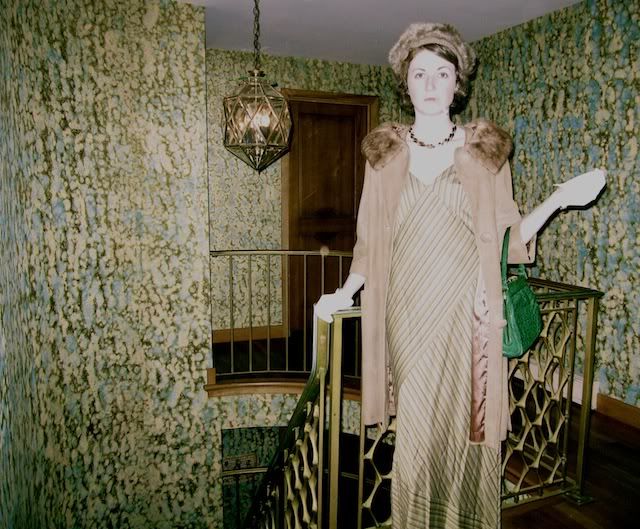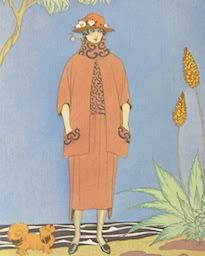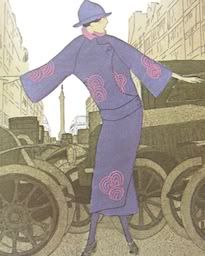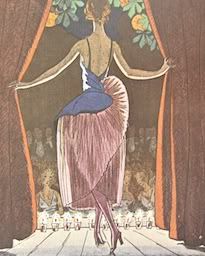
Oh, this old thing?
Hello. Agnes here and welcome back for another feature of fashion highlights from decades past. Today I will obsess over French fashion plates that were published in La Gazette du Bon Ton during its run from 1912 to 1925. The magazine was marketed toward the Parisian elite and was arguably the most influential fashion magazine of its time. It's title was derived from the French concept of bon ton, meaning timeless good taste and refinement. The editor of the magazine, Lucien Vogel, was able to enlist the most successful couturiers and the finest illustrators working in Paris. The results are awe-inspiring, see for yourself.



from left to right:
HAVE I COME TOO EARLY?
Theater Wrap by Paul Poiret. Drawn by Georges Lepape, 1912.
WOMAN AND PUPPETS.
Marionettes. Drawn by Georges Lepape, 1913.
TOO MUCH TO CHOOSE FROM.
Tailored Suit by Paul Poiret. Drawn by Georges Lepape, 1913.
The purpose of the illustrations was to establish fashion as an art alongside painting, sculpture, and drawing. Thus making the fashion plates a stepping stone for fashion illustration and fashion photography through its use of picturesque settings, vivid colors and eye catching poses. As quoted in the magazine's first editorial, "The clothing of a woman is a pleasure for the eye that cannot be judged inferior to the other arts."



AUTUMN CROCUSES.
Traveling Cloak by Paquin. Drawn by George Barbier, 1914.
AT THE COMEDY.
Theater Wrap by Paquin. Drawn by J. Gose, 1912.
THEY'RE LOOKING AT US.
New Summer Muffs. Drawn by Georges Lepape, 1913.
Each issue of La Gazette du Bon Ton featured ten full-page fashion plates. Seven depicting couture designs and three inspired by couture but designed solely by the illustrators. The freedom given to the illustrators led to an intimate and fascinating social commentary much like the current street photography being done by the genius that is Bill Cunningham at the New York Times.



THE STUNNING LITTLE FISH.
Summer Dress. Drawn by George Barbier, 1914.
AT PALM BEACH.
Tailored Outfit by Worth. Drawn by George Barbier, 1921.
THE SEASHELL FOUNTAIN.
Evening Gown by Paquin. Drawn by George Barbier, 1914.
The magazine both created and recorded fashion history in the crucial years that transitioned from the decadent and lavish belle époque through the typical look of the mid twenties and the art deco movement: sheath dresses, boyish bobs, geometric symmetry and true glamour.



THE ANTIQUE MINIATURE.
Dinner Gown by Redfern. Drawn by Bernard Boutet de Monvel, 1913.
AVENUE DU BOIS.
Drawn by Drian, 1915.
COROMANDEL.
Evening Wrap and Gown. Drawn by George Barbier, 1914.
Rather than merely showing off the featured garment, the fashion plates serve as a window to the 1920's and its upper class lifestyle, manners, social environments, and leisure pursuits through including dramatic and narrative situations. My personal favorite being "THE BEAUTIFUL LADY WITHOUT PITY" for obvious reasons.



ALMS.
Fancy Tailored Outfit. Drawn by Georges Lepape, 1914.
THE LADIES' ADVISER.
Theater Gown and Wrap. Drawn by George Barbier, 1913.
FROM THE APPLE TO THE LIPS.
Masquerade Costume by Redfern. Drawn by Charles Martin, 1913.
The couture pieces include gorgeous evening gowns, tailored suits, walking and summer outfits, theater, ballroom and masquerade costumes. Resulting in a fashion show of women’s wear from pre depression era Paris when the most daring, luxurious designs were customary seasonal additions to the wardrobe.



THE BEAUTIFUL LADY WITHOUT PITY.
Evening Gown by Worth. Drawn by George Barbier,1921.
SMOKE.
Evening Gown by Beer. Drawn by George Barbier, 1921.
THE MILKY WAY.
Evening Gown and Cape by Worth. Drawn by George Barbier, 1921.
The extremely rich and vivid colors were achieved through fine pochoir hand coloring. Pochoir is the French word for stenciling, a form of coloring pictures that dates to a thousand years ago in China. The manual aspect of pochoir has been both one of its most valuable attributes and one of its greatest failures as a medium. Pochoir is both labor-and time-intensive, making it an expensive and slow process of printmaking.



PARISIAN ENCUMBERANCES.
Afternoon Coat by Doeuillet. Drawn by Andre E. Marty, 1920.
GOODNESS, HOW COLD IT IS.
Winter Coat by Paul Poiret. Drawn by Georges Lepape, 1913.
BY MOONLIGHT.
Evening Wrap by Paul Poiret. Drawn by Georges Lepape, 1913.
The pochoir process would use from 20 to 250 different stencils applied to a black-and-white collotype print from a photograph. A craftsman known as a découpeur would cut stencils with a straight-edged knife. The stencils were originally made of aluminum, copper, or zinc. Stencils created by the découpeur would be passed on to the coloristes. The coloristes applied the pigments using a variety of different brushes and methods of paint application to create the finished pochoir print.



WITCHCRAFT.
Evening Gown by Beer. Drawn by George Barbier, 1922.
THE MIRROR / A PASSING GLANCE.
Evening Wrap by Paul Poiret. Drawn by Andre E. Marty, 1922.
THE PROLOGUE / AMATEUR PERFORMANCE AT THE COUNTRY ESTATE.
Evening Gown. Drawn by Pierre Brissaud.
Well I'm spent. Check back soon for more salivating vintage tidbits.
Yours truly,
Agnes

2 comments:
Those illustrations are so gorgeous, what an interesting post!
I'm loving all the vintage photos and info!
Post a Comment